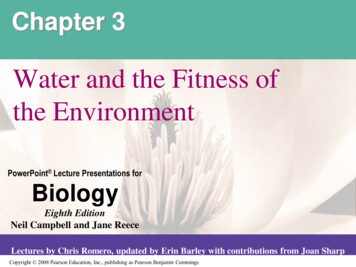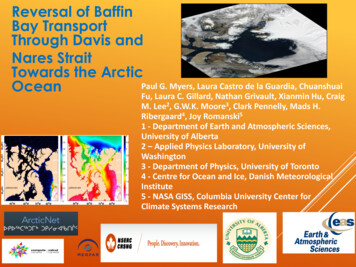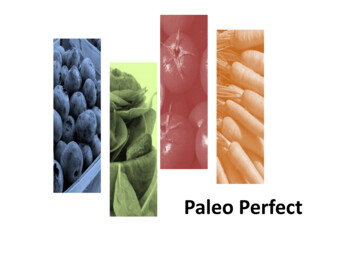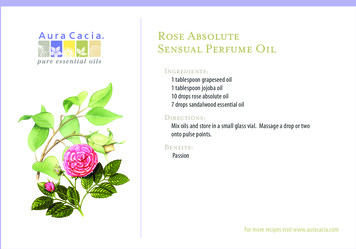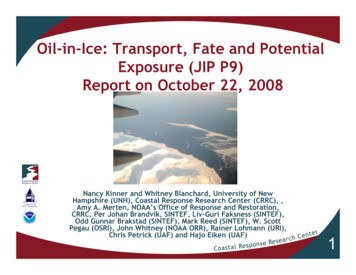
Transcription
Oil-in-Ice: Transport, Fate and PotentialExposure (JIP P9)Report on October 22, 2008Nancy Kinner and Whitney Blanchard, University of NewHampshire (UNH), Coastal Response Research Center (CRRC), ,Amy A. Merten, NOAA’s Office of Response and Restoration,CRRC, Per Johan Brandvik, SINTEF, Liv-Guri Faksness (SINTEF),Odd Gunnar Brakstad (SINTEF), Mark Reed (SINTEF), W. ScottPegau (OSRI), John Whitney (NOAA ORR), Rainer Lohmann (URI),Chris Petrick (UAF) and Hajo Eiken (UAF)1
Overall CRRC Mission Joint partnership between NOAA’s Office ofResponse and Restoration (ORR) and theUniversity of New Hampshire Develop new approaches to spill responseand restoration through research/synthesisof information Serve as a hub for spill research,development, and technical transfer Oil spill community (national and international)2
Species Sensitivities to Oil30Neanthes arenaceodentataArtemia salina25Cancer magisterSpecies or Group RankEualus spp.PimephalespromelasCyprinodonvariegatusLepomis macrochirusIctalurus punctatus20Palaemonetes pugioDaphnia magnaM orone saxatilis1510 spp. benthic amphipodsChironomus sp.Callinectes sapidus10Crango franciscorum5Salmo truttaElasmopus pectinicrusAedes spp.Oncorhynchus mykissM icropterus salmoidesEurytemora affinisNeomysis americana, Mysidopsis bahiaOncorhynchus spp., Salmo sp., Salvelinus sp., Thymallus sp.Penaeus aztecusOncorhynchus gorbuschaPandalus goniurus0020406080100120LC50 (ppb total PAHs)French-McCay 2002.3
Measuring Biological Effects Estimating “impacts”? Basic Risk EquationChemical ExposureToxicological Response-Route ofUptake-Mode/Mechanism oftoxicity -Concentration- Lethality-Duration-Changes in growthand -Changes in behavior-Population levelparameters4
Measuring Biological Effects Estimating “impacts”? Basic Risk EquationToxicological ResponseChemical Exposure-Route ofUptakeKnown-Mode/Mechanism oftoxicity -Concentration- Lethality-Duration-Changes in growthand -Changes in behavior-Population levelparameters5
Measuring Biological Effects Estimating “impacts”? Basic Risk EquationToxicological ResponseChemical Exposure-Route ofUptakeKnown-Mode/Mechanism oftoxicity -ConcentrationUnknown- bolism-Changes in growthand reproduction-Changes in behavior-Population levelparameters6
Measuring Biological Effects Estimating “impacts”? Basic Risk EquationToxicological ResponseChemical Exposure-Route ofUptakeKnown-Mode/Mechanism oftoxicity -ConcentrationUnknown- Lethality-DurationUnknown-Changes in growthand -Changes in behavior-Population levelparameters7
Measuring Biological Effects Estimating “impacts”? Basic Risk EquationToxicological ResponseChemical Exposure-Route ofUptakeKnown-Mode/Mechanism oftoxicity -ConcentrationUnknown- on,metabolism-Changes in growthand reproductionUnknown-Changes in behavior-Population levelparameters8
Idealized Arctic First Year IceFood WebAIRSurfaceICEDissolved &particulate oil2º Producers/zooplankton(amphipods)1º ProducersMicrobial loopSEA WATERWaterdepth1º ProducersSedimentation of particulates(including small oil droplets& oil sorbed to particles)ZooplanktonPelagic Feeders(fish, marine mammals)BENTHOSMicrobesFishInvertebrates9
Seasonal Progression of Oil Frozen into Ice Field inWinter, and Released During Melting and Breakup inSpring10
Primary components of study are:1. Transport of dissolved crude oilhydrocarbons in ice2. Biodegradation of crude oilhydrocarbons in ice3. Modeling of the transport andbiodegradation of crude oilhydrocarbons in ice11
Questions study addresses are:What are transport and degradation processes (partitioning,advection, diffusion, and biodegradation) and rates that govern fateof oil components frozen in ice?How does change of ice microstructure dynamics affect transport?What are exposures (e.g., composition, concentrations and durations)to which ice-associated organisms (e.g., microbes and protists) maybe exposed?How will response options affect transport and biodegradationprocesses?12
Peer Review Process for Proposal Team meeting at SINTEF in January 2008 Proposal peer reviewed by 5 external reviewers Confidentiality Team response to reviewers commentsResubmittal to peer reviewers for approvalProposal approvedQA plans submitted and approvedUAF and URI contracts signedSINTEF contract being signed 548,000 (CRRC OSRI)13
Step-wise Approach Transport/exposure laboratory studies: Determine how ice growth conditions affect transport andfate of entrapped oil in ice Collect quantitative data on partitioning of oil components(bioavailable fractions) into brine inclusions and channels Determine rates of vertical transport; Biodegradation laboratory studies: Determine extent of crude oil biodegradation in marinesea ice; Quantify contribution of biodegradation to depletion ofhydrocarbons compared to other depletion processes; Develop oil-in-ice sub-model14
Bulk oil iniceIdealized Arctic Food WebDiffusionAIRIceSurfaceICEDissolved &particulate oil2º Producers/zooplankton(amphipods)1º ProducersBulk OilMicrobial loopIce with BrineChannelsSEA WATERWaterdepth1º ProducersSedimentation of particulates(including small oil droplets& oil sorbed to elagic Feeders(fish, marine mammals)BENTHOSdropletsSea WaterMicrobesFishInvertebrates15
Behavior Experiments – SINTEFLiv-Guri Faksness (PI) Objective: investigate howtemperature influences oilbehavior during thawingFreezing ice cores 8 Transparent poly carbonatecylinders inner dia. 144 mm height 80 cm Temperature controlled, -20 C Insulated, heating panels placedat bottom 3 mm oil (Statfjord) film in iceSchematic of equipment forfreezing ice cores in thelaboratory16
Experimental DesignPhase I: (no oil) Freeze-thaw cyclestimes Sampling techniques Initial SPME testingPhase II: Sampling techniquesPhase III: ReplicateChemical Analysis SVOC (PAHs andphenols): GC/MS TPH: GC/FID Volatile organiccompounds (C5-C9),BTEX: P&T GC/MSIce Characterization(UAF) X-ray computedtomography (CT)17
Phases 1, 2 and 318
Passive Samplers 2 Sampling techniques Polyethylene (PE) sheets Solid-phase microextraction (SPME) Not validated for oil spills in coldclimates Objective: Verify equilibrium partitioningconstants Include performance referencecompounds (PRCs) in PE matrix (forkinetic uptake)Possible experimentalapproach for SPMEs inice core columns19
Update: Use of passive samplersRainer Lohmann (Univ. of Rhode Island) PE deployments, Summer 2008, Loss of PRCs inNarragansett Bay Small PAHs need 10 days to reach equilibriumCompoundLog KPE-w % left after 8 days 7d12-benzo(a)pyrene6.279%12420
Dissolved Concentrations of PAHs for PEs and Active Sample11001000900800Cdissolved (pg/L)7006005004003002001000Phenanthrene2 day, PEFlouranthene4 day, PEBenz[a]anthracene8 day, PEBenzo[a]pyrene8 day, Active Sample21
Dissolved Concentrations of PAHs for PEs and Active Sample11001000900800Cdissolved (pg/L)700600500400Use of PRCs – Good Predictionof Dissolved PAHConcentrationsAfter 2 days3002001000Phenanthrene2 day, PEFlouranthene4 day, PEBenz[a]anthracene8 day, PEBenzo[a]pyrene8 day, Active Sample22
Update: Oil/WSF Entrainment and Movement in IceHajo Eicken, Jonas Karlsson, Mette Kaufman (UAF)Cold-lab experiments: Synthetic oil & North Slopesweet crude Oil entrainment andmigration experiments: Temperature Salinity Oil flow rate after onset ofmigration Oil content and microdistribution23
Update: Oil/WSF Entrainment and Movement in Ice Progress on experiments/data analysisJ. Karlsson Oil properties Small-scale experiment Meeting with Liv-GuriFaksness (SINTEF) in Nov08 to discuss experimentprogress Financial support of thiscomponent of JIP throughOil Spill Recovery Institute(OSRI), Cordova, AK(Contract 10-13-08)24
Biodegradation - SINTEFWill biodegradation contribute to the HCdepletion in ice (WSF and oil droplets)? Artificial brine -5 C, 100 psu -10 C,145 psu Bacterial inocula 90 m depth, SINTEF lab Simulated oilDroplet/adsorbed oil Oil films (10-20 μm thick) Fluortex fabric adsorbents(1 cm2) Water-soluble fractions(WSFs), CROSERFmethod 1: 1000, oil: water 1: 10000, oil: water Nutrients(100: 5: 0.1, C: N: P)25SINTEF
Experiment 1 and 226
Experiment 3Effect of Protist Predation on BiodegradationTemp.( C) 50-5-10ProtistsSampling time (days)0369121515 – 84 (every 3rd day) XXXXXXX-XXXXXXX XXXXXXX-XXXXXXX XXXXXXX-XXXXXXX XXXXXXX-XXXXXXX27
Analytical MethodsDecalines, phenols, napthalenes, PAHs: GC-MSBTEX: P&T GC-MSMicrobiological: epifluorescence (DAPI)Heterotrophic microbes and oil-degradingprokaryotes: viable counts Eukaryotic protists: most probable number Chlorophyll: fluorometric analysis Change in microbial communities: DGGE 28
Modeling SINTEFObjective: to develop and test module that can eventuallylink oil spill models to large-scale coupled sea icehydrodynamic models Model development 2D single-phase flow(Petrich et al. 2006) Modified Include bulk oil as asource for dissolved Diffusion-advection ofdissolved HCs Solar insulation Physical-chemicalprocesses governing oilbehaviour Multi-phase version Anticipated variables: Porosity (total) Permeability(or effective porosity) Thickness Temperature gradient(vertical) Salinity(brine concentration) Oil concentration(by component)29
Update: Fluid Dynamics ModelProgressPlans Application design Meeting w/ Whitney Blancharddeveloped (open(UNH) in Nov 08 to discusssource C code, Linux)implementation Entered code atPorosityimplementation stage Skeleton code w/primitive boundaries Preliminary matrixsolver Not all differentialequations solved01C. Petrich30
Next Steps/Timeline31
Discussion and Questions32
Extra Slides33
Species sensitivities to Oil30Neanthes arenaceodentataArtemia salina25Cancer magisterSpecies or Group RankEualus spp.PimephalespromelasCyprinodonvariegatusLepomis macrochirusIctalurus punctatus20Palaemonetes pugioDaphnia magnaM orone saxatilis1510 spp. benthic amphipodsChironomus sp.Callinectes sapidus10Crango franciscorum5Salmo truttaElasmopus pectinicrusAedes spp.Oncorhynchus mykissM icropterus salmoidesEurytemora affinisNeomysis americana, Mysidopsis bahiaOncorhynchus spp., Salmo sp., Salvelinus sp., Thymallus sp.Penaeus aztecusOncorhynchus gorbuschaPandalus goniurus00204060LC50 (ppb total PAHs)French-McCay 2002.80100120
Conceptual ModelFood Web CyclePelagic Feeders(fish, marine mammals)
Transport/Exposure MechanismsDiffusionIceBulk oil encapsulated in ice from below measure dissolved constituents(WAF - e.g., PAHs)Bulk OilIce with BrineChannels1mDensity of brine transport downward will transport dissolved (bioavailable)components of oil downwardCparticulatesBiodegradationCoil dropletsDiffusionSea Water36
POSSIBLE EXPERIMENTAL APPROACH FREEZINGICE CORESSPME fibersInsulated box in freezerHeating element37
Transport, Fate and Potential Exposureof Oil-in-Ice: Objective(P9) Estimate routes and magnitudes of: Potential environmental exposures Concentrations of oil components During migration through the ice regimeduring a freeze-thaw cycle38
Transport, Fate and Potential Exposureof Oil-in-Ice: Goals (P9) Transport (Behavior) of water solublefraction (WSF) from crude oil in ice Investigate how ice conditions affect fate andtransport of encapsulated oil in ice Collect data on the partitioning of oilcomponents (bioavailable fractions) into brineinclusions and channels Determine rates of vertical transport39
Transport, Fate and Potential Exposureof Oil-in-Ice: Goals (P9) Biodegradation of WSF from crude oil in ice Determine extent and time span crude oilbiodegradation takes occurs in ice Compare biodegradation rates to otherdepletion processes Determine whether naturally-occurringpredation can hinder biodegradation40
Transport, Fate and Potential Exposureof Oil-in-Ice: Goals (P9) Modeling the fate and transport of WSF inice Develop an oil-in-ice transport model41
14 Step-wise Approach Transport/exposure laboratory studies: Determine how ice growth conditions affect transport and fate of entrapped oil in ice Collect quantitative data on partitioning of oil components (bioavailable fractions) into brine inclusions and channels Determine rates of vertical transport; Biodegradation laboratory studies:





